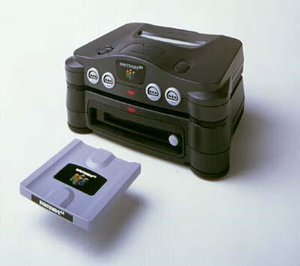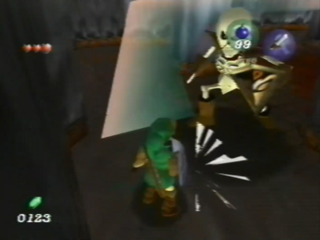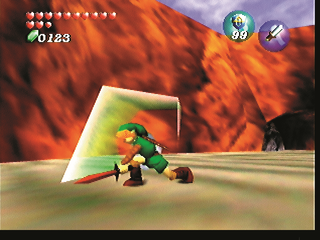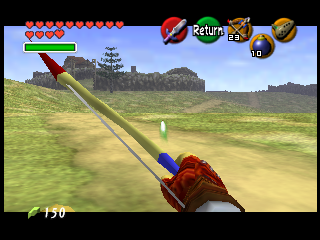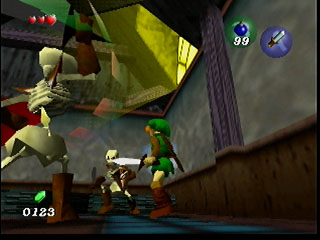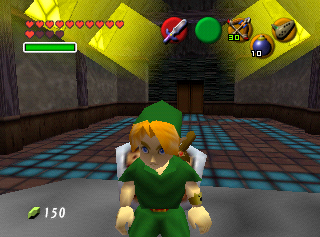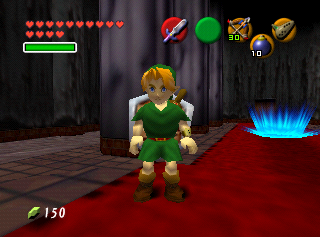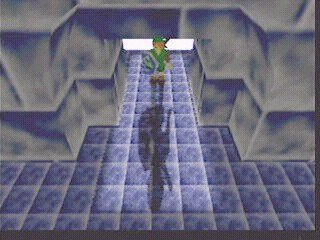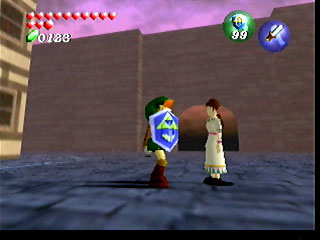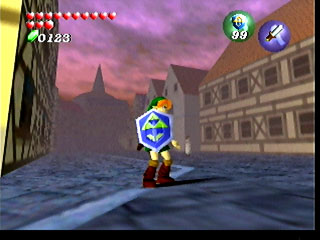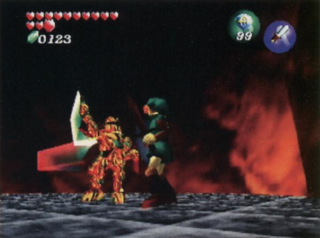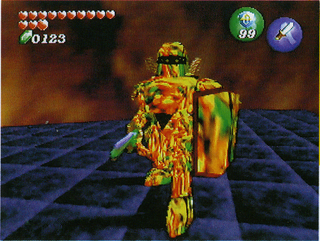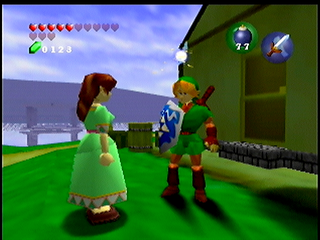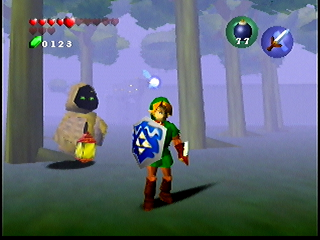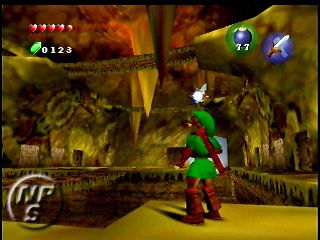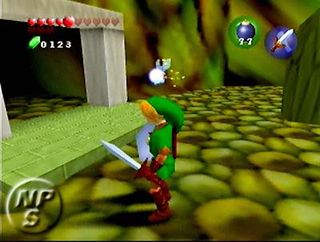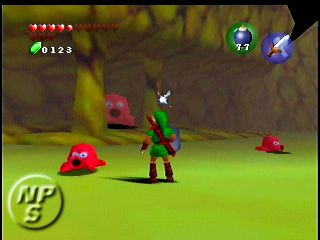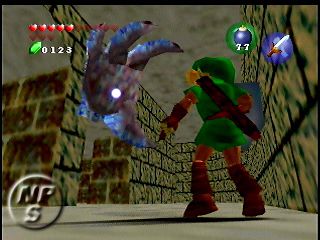Prerelease:The Legend of Zelda: Ocarina of Time/A + B
This is a sub-page of Prerelease:The Legend of Zelda: Ocarina of Time.
Contents
64DD
At the outset of its development, Ocarina of Time was intended to debut on the then-unreleased Nintendo 64 Disk Drive (64DD), a disk-drive add-on for the Nintendo 64. The 64DD, like the Famicom Disk System, read data from proprietary magnetic disks, which had more storage space than N64 cartridges at the time; by the end of the N64's life cycle, however, cartridges did eventually get large enough to match the storage capacity of the 64DD's disks. Miyamoto's ideas for making use of the extra memory included recording Link's footprints.[1]
Despite its advantages, however, the 64DD's disks came with their own set of technological restraints that eventually led the developers to release Ocarina of Time as a cartridge.
"ROM cartridges don't have moving mechanical parts, so you can retrieve motion data in an instant wherever it is, but with a magnetic disk, it takes time to move certain mechanical parts, so depending on where the data is, it takes time to retrieve it, so you couldn't make Link move. If there weren't many movements and you could fit them in the memory, you could read them to memory from the magnetic disk beforehand, but there were 500 patterns." - Satoru Iwata[1]
Additionally, the 64DD was undergoing one of many developmental delays that plagued the add-on in the years leading up to its release; delays such as this also ended up playing a large factor in the shifting of Ocarina of Time and numerous other 64DD games to standard cartridge releases.
Camera
When questioned by Famimaga 64 about what differentiated Zelda 64 from Mario 64, Miyamoto was quick to mention the camera system. Further statements indicated that the staff was still playing around with the camera, trying to figure out the best way to display their new title.
"Scenes in the final version will be quite different from those in the video," he said. "But you will still see some scenes from the same angles that you saw in the video. We aren’t sure if it’s the best angle for actually playing. It’s possible to make demo scenes from that angle - they aren’t difficult to create." - Shigeru Miyamoto
One of the camera configurations the team experimented with was a first-person perspective. In fact, Miyamoto was the one to suggest it in a conversation with Koizumi. The game's producer envisioned Link exploring the world in first-person, with the camera switching to third-person during enemy encounters and battles being viewed from a sideways perspective, similar to the system of Adventure of Link.[2]
Director Toru Osawa and program director Toshio Iwawaki recalled that they gave it a shot, but decided it wasn't visually interesting and returned to a third-person view. Koizumi, who created Link's design, confessed that he couldn't stand the thought of not being able to see the "cool" character into whom he'd invested his creativity.[3]
However, for designers still getting used to developing games in 3D, making the game in a third-person perspective presented its own set of challenges. Koizumi was already familiar with the complexities of displaying a character running around a broad field from his work on Super Mario 64. He related that it was difficult to get Zelda 64's graphics to connect correctly, which resulted in him making many hard requests of Iwawaki, the head programmer.[3] Satoru Iwata, fourth president of Nintendo, remembers it was said that, for those who developed games on the Nintendo 64 system, making one character was equal to the difficulty of making all the game's backgrounds.[2]
Designing the camera and battle systems were two of the tasks whose hardships were compounded due to the choice of third-person over first-person. In order to solve these issues, the developers created a number of new techniques, including Z-targeting.[3]
November, 1996
In November 1996, the second Zelda 64 trailer was unveiled at Shoshinkai, which had by then become known as Space World.[4] [5] Unlike the tech demo of 1995, this footage featured actual gameplay from the developing title.[4] [5]
Story
Though Ocarina of Time is famous for time travel and the dual worlds of Child and Adult Link, developers did not conceive of the game mechanic that would contribute to its namesake until halfway through development. At this early stage of production, only Adult Link could be manipulated by the player. Osawa connected this to the designers' focus on chanbara, stating that a child would be at a disadvantage against large enemies, with a small sword and a short reach, making an older Link only natural.[6]
Actions
Running
| November 1996 | January 1997 | Final |
|---|---|---|
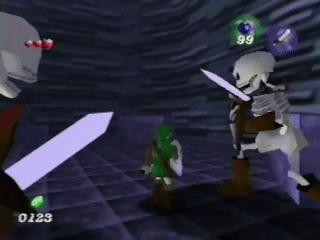
|

|
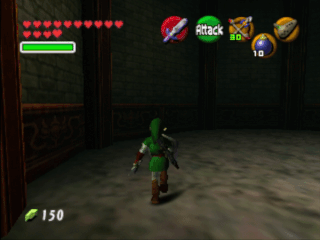
|
Link's running animation wasn't as polished right away. In January 1997 his running animation was closer to final, but his left hand didn't swing as much. In May 1997 his running animation was finalized.
Shield
Link's shield would block attacks even if you didn't press the R button to shield with it.
Interface
The first instance of a graphical user interface (GUI) for Ocarina of Time echoed the classic A + B interface from The Legend of Zelda and Link's Awakening.
| The Legend of Zelda | Link's Awakening | A + B |
|---|---|---|
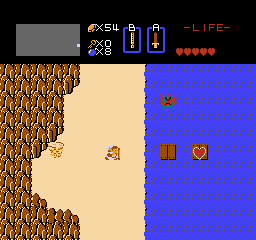 |
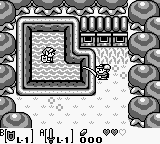 |

|
| GUI | Only the A and B buttons are displayed on the screen. The letter is written in white on each button's icon. |
| A Button | Link's sword is equipped to A. |
| B Button | 99 bombs are equipped to B. |
| Hearts | Link has 3 full hearts, which appear at the top left of the screen. |
| Rupees | The rupee counter is found on the bottom left and reads 0123. Its font strongly resembles the one found in The Legend of Zelda: A Link to the Past. |
Items
The first items shown in the game, Link's sword and bombs.
Link’s Model
The squat, super-deformed version of Link that appeared in the 1995 tech demo was reminiscent of the simplicity of his design in the first two Legend of Zelda games. In the 1996 trailer, his look had been updated to appear less cartoony and more mature, setting the tone for the realistic nature of Ocarina of Time's graphics.
Nintendo evidently experimented with a variety of designs for this new, mature Link before deciding which to model. One of these illustrations, seen in the middle, was revealed in the official Nintendo-endorsed Zelda encyclopedia Hyrule Historia.[7]
Koizumi changed Link's initial design based on input from his wife, who complained that all Nintendo characters had funny noses, and that there weren't any handsome ones. As a result, he changed Link's button nose to a pointed one, reduced his sideburns, and added earrings to make him more attractive. However, concerned that making Link "too cool" would go against Nintendo's style, Koizumi made him wear long underwear beneath his tunic.[8]
| Dec. 1995 | Concept Art | Nov. 1996 |
|---|---|---|
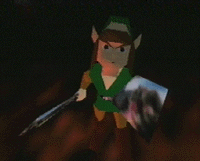 |
 |

|
| Hair | Link's hair has turned from brown to strawberry. |
| Face | His expressive face is now more mature and realistic. |
| Outfit | His tights have disappeared, and brown sleeves cover his arms. |
| Sword | Link wields a wide-bladed sword with a black hilt. |
| Shield | His shield, formerly a flashy, metallic silver, now features a simple Triforce design. |
Stalfos
The original look of the Stalfos is much plainer than the creatures' final design, and appear to bleed a blue spray of blood when hit. Its actor, En_Skeleton, is not present in the final game but was found in the July 2022 iQue leak. Its actor ID is 0001, meaning Stalfos were the second actor to be added to the game, following Link himself. The revised Stalfos actor used in the game was added next and is named ovl_En_Test. En_Test was probably used to test other entities prior to being repurposed for the final Stalfos.
| Nov. 96 (En_Skeleton) | Final (En_Test) |
|---|---|

|

|
Effects
Blur
| Sword (Nov. '96) | Arrow (Final) |
|---|---|
The green blur color the sword used to use in this development phase was reused for the arrows. The arrows had a white blur color in the game's E3 1998 demo, so the change was made pretty late.
Environments
Though brief, the Space World trailer gave fans a glimpse of the variety of environments Nintendo was crafting for their brand-new game.
Many of these images share similarities with locations shown later in January 1997, particularly the town and mountain area. They also feature shared textures, with the sky area and dungeon having the same floor and wall textures as the Stalfos Miniboss Room. Link also briefly uses a real-time dynamic shadow, which is still present in the final game in an actor called En_Sda.
Stalfos Miniboss Room
This room is called ちゅうスタロフォスベや (Stalfos Miniboss Room), or "syotes" (short for "show test"). This blue and brown-tiled chamber has light streaming through the windows and a raised dais at the far end of the room, along with a non-functional double door textured into the wall.
| To do: More shots of syotes in Debug ROM and overdump, preferably with Adult Link. |
Despite the fact that it was removed from the released version of Ocarina of Time, it was kept in debug builds of the game, in which it can be accessed by using the map select menu. The room lacks a header in the debug builds, leaving it unknown which objects and music was in by default. The room was also found in the 1997 overdump with its actor and object files partially intact, most notably having Tailpasarans present.
Boss Stalfos Room
| To do: More shots of syotes2 in Debug ROM and overdump, preferably with Adult Link. |
In this area, footage depicts Link's battle against a giant Stalfos boss who dropped down from the ceiling. It is known as the ボススタロフォスベや (Boss Stalfos Room) in the map select menu, or "syotes2" (show test 2), and is also present in the Debug ROM.
This red-carpeted hall is lined by stone columns, with a tiled floor and a raised dais at the far end of the room, and with a non-functional double door textured into the wall. A blue post-boss warp that sits in the center of the room drops Link in Hyrule Field, right in front of Hyrule Castle Town's drawbridge. Background music is not present, and the carpet makes the odd sound of flesh being stepped on like Jabu-Jabu's belly, heavily suggesting that music and sound were rearranged.
As before, the Debug ROM does not contain a Stalfos, while the overdump does, revealing that the room may have been used to test various boss fights alongside being a showcase.
Town
A massive 3D town. In these November 1996 screenshots human NPCs are not seen while they appear later in January 1997 screenshots.
Mountain Area
Link is running around a mountain. He's seen walking outside and inside. In screenshots from January 1997, a cave entrance can be seen. Some screenshots from that time also show Link fighting enemies inside a cave.
Triforce Room
Link opens a glowing blue chest containing the Triforce in a water-filled room. The textures in this area were borrowed from Super Mario 64. The wall is the one Peach's Castle uses, but it has been inverted to be dark. The blue floor tiles and the chest are both from the Bowser in the Dark World battle arena, with no modifications made.
Zelda 1 Dungeon
A room resembling a dungeon from the first Zelda game. Square obstacles are placed around and there are two Stalfos to fight against. A tunnel can also be seen. The time of day used to change in interiors, as seen between the included screenshots.
Tower Rooftop
Link is taking a view on top of a tower during stormy weather. There's some resemblance to fstdan's top floor, which is part of old Ganon's Tower. In one of the screenshots, something unknown is seen. It's plausible it was depicting Death Mountain in the distance. It's got an orange-ish texture, and above it there may be a smoke cloud.
January, 1997
Specifications
Following their attendance of Shoshinkai 1996, German gaming magazine Total! noted in their Jan. 1997 issue that the 64DD was said to be operational and ready for production, but still without a price, release date, or games.
It was hoped that Zelda 64 would debut as the first 64DD game, which the publication boasted that Shigeru Miyamoto would make use of to create complex game worlds "in which every action and change by the player also permanently [changed] the world." One example given was that of Link picking a flower, and new vegetation growing in its place as the game progressed.
However, Total! noted that it was, as yet, unclear whether Zelda would be released as a 64DD title, or on a cartridge. The magazine drew parallels between Nintendo's uncertainty about whether the 64DD would be commercially viable, and the downfall of its quickly-forgotten SNES CD-ROM system. It reported that the company was waiting for certain conditions to bring the N64 accessory to market, such as high sales for the N64 in Japan, tolerant customers, and a second big-name launch title that would strengthen confidence in the system.
"For now," wrote Total!, "Practically two versions [of Zelda 64] are in development — just in case." The second version was said, by Miyamoto, to be "a slightly different variation of the game.[9]
Action
Link shows off his sword-fighting prowess, reflecting the game's chanbara influences.
Interface
| Nov. 1996 | Jan. 1997 |
|---|---|
 |
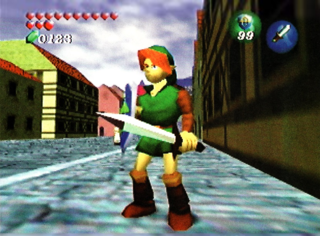
|
| GUI | As before, A + B are used for equipping items. |
| A Button | Link's sword is equipped to A. |
| B Button | 99 shields are equipped to B. |
| Hearts | Link now has 13 full hearts. |
| Rupees | The rupee counter has moved to the top-left of the screen, under the hearts. |
Items
Shield
The fact that the design on the shield icon is identical to the shield Link carries is more apparent if one zooms in on the icon. The shield button also sports a counter like the bombs for some reason.
Characters
The Woman in White
There is not a lot of official information about this woman, the first human character to appear aside from Link. Because she appears in at least three different locations in the early town, and because her character seems to vary in size, she may have been a generic human NPC that the developers were using to test Link's interactions.
She was likely used with En_GirlA, the 5th entry in the game's actor list. The contents of En_GirlA have since been overwritten with the data that determines the stock sold by shopkeepers.[10]
Due to similarities in appearance, fans have speculated that she is the same character as the woman in green that appears in a single screenshot from April.
Environments
Revisited - Stalfos Miniboss Room
Another look at syotes, showing a door in the back of the room and the ceiling's support structure.
Revisited - Town
The large town glimpsed in the 1996 Shoshinkai trailer is now depicted with a skybox. From the several screenshots available of this town, it is seen to be composed of blocky houses surrounded by a big stone wall with a gate. Various attempts to recreate the town have been made by fans.
A structure resembling a spiked tower is visible, rising above the rooftops.
In this screenshot, Link is standing closer to the spike structure. Object_human is standing next to two buildings.
Revisited - Mountain Area
Link shows off some sword slashes and fancy acrobatics. In the background, a cave enters the side of the mountain.
Link doing a jump with no clear ledge in sight, implying he used to be able to jump on his own.
Mountain Cave
Link battles a Stalfos near the mouth of the cave.
Tiled Cave
An Iron Knuckle flourishes its sword in a cavern with a tiled floor.
Enemies
Revisited - Stalfos
This Stalfos wields an orange blade. It is unclear whether the change in hue is a result of the lighting or a redesign.
Iron Knuckle
An enemy later confirmed to be the Iron Knuckle in Nintendo Power #94 peers at Link with cat-like eyes through the slit in its visor. It was the fourth actor to be added into the game, as revealed by the iQue leak.
March, 1997
Specifications
N64.com reported on several details pertaining to the game's size and format. According to the site's Japanese correspondent, the game's size was estimated to be 12 MBs, and the title would use more of the N64 hardware than Super Mario 64. The latter only utilized around 60% of the system's power.[11]
Release Date
N64.com also stated that Zelda 64 would be released in cartridge format on the N64 in late 1997.[11]
64DD
It was noted that a 64DD-based version of the game would be released soon after its cartridge debut, which would have more back-up capabilities and work simultaneously with the cart.[11]
Models
Wireframe view screenshots of the models of Link and Stalfos were provided to magazines and can be seen in the February 14 issue of Famimaga 64 and the March issues of Nintendo Power and Marukatsu Game Shonen. The images provide us with a glimpse of how Link's second-earliest model appeared in wireframe form.
| Jan. '97 Model | Mar. '97 Wireframe |
|---|---|

|
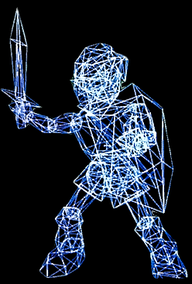  
|
The Stalfos wireframe is notable in that it differs from any Stalfos model depicted in screenshots before or since.
| Jan. '97 Model | Mar. '97 Wireframe |
|---|---|

|
 
|
Story
With development still in its early stages, only a barebones summary of the game's story was made available to prospective players.
"As for the story, Mr. Miyamoto's team isn't saying much at this time, but the action takes place in Hyrule and the Triforce and Ganon also will play roles." - Nintendo Power[12]
April, 1997
April brought another set of screenshots distinguishable via additional interface redesigns.
Interface
| January 1997 | April 1997 |
|---|---|
 |
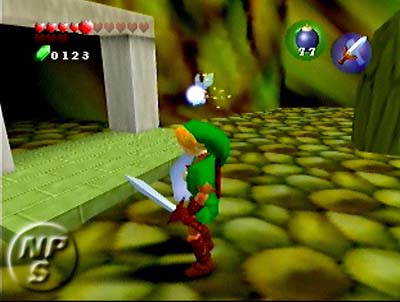 |
| GUI | A + B are still used for equipping items. The icons combine when the bow is equipped. |
| A Button | Link's sword is equipped to A. |
| B Button | 77 bombs are equipped to B. The item counter font is smaller and no longer italicized. |
| Hearts | Link's hearts have dropped to 5 out of 10 hearts. |
| Rupees | The rupee counter's position is unchanged, but the font used for the numbers is smaller. |
Link’s Model
| Jan. '97 | Apr. '97 |
|---|---|
 |

 |
| Hair | Link's hair has turned from strawberry to blonde. |
| Face | His face retains the mature look from before, but now it resembles that of the final game. |
| Outfit | His sleeves, once light brown, are now orange. Gloves adorn his once-bare hands. The rims of his boots have changed from gold to orange, and his legs are clad in matching orange tights. |
| Sword | His sword has changed from a dark-hilted blade to a light brown, its icon updated accordingly. |
| Shield | His shield has been redesigned. The clunky yellow Triforce has been replaced with a sharp gold version, the borders have been stylized, and a white flourish is present at the top. |
| Nov. '96 - Mar. '97 | Apr. '97 | Concept Art |
|---|---|---|
 |
 |

|
This version of Link's appearance is visible in early concept art for the game that was later published in Hyrule Historia.[7] It's interesting to note that while Link's concept art always depicts him with a bandolier across his shoulder from this point forward, the strap was never incorporated into his in-game model.
However, the bandolier was revived for Majora’s Mask, and also implemented in the 2011 remake Ocarina of Time 3D.
Items
Sword
![]() Link's sword icon has changed from a small, dagger-like blade to one bearing a proper hilt.
Link's sword icon has changed from a small, dagger-like blade to one bearing a proper hilt.
Bombs
![]() This bomb icon is larger than the one that appeared in the screenshots from November 1996.
This bomb icon is larger than the one that appeared in the screenshots from November 1996.
Bow
 Link is now able to fend off his enemies with a bow. His arrow count is 99.
Link is now able to fend off his enemies with a bow. His arrow count is 99.
Characters
In April 1997, fans got their first look at Navi, Link's fairy companion. Navi started life as a simple upside-down triangle marker, part of the prototype battle system that would later develop into Z-targeting. The triangle appeared over the heads of enemies to make it easy for players to see which enemy they were targeting.[6]
Koizumi, director and character designer, objected to using such a simple marker and came up with the idea of a fairy to fit the theme of The Legend of Zelda. Koizumi envisioned the fairy as a cute girl, but displaying such a character wasn't possible on the system due to the Nintendo 64's technical limitations. Instead, he opted to make a ball of light with wings, calling it the "Fairy Navigation System". He showed his design to Osawa, the script director, who suggested that they name it Navi, short for "navigation".[6]
Osawa later noted that he named Navi out of respect for the series' naming tradition. Other monikers from The Legend of Zelda series reflect their origins and serve as functional symbols, something that is important to Miyamoto. Link, for example, means "to bind together".[6]
Navi did not appear to change color at this point in time.
The Woman in Green
This NPC, named object_human in the game's files, wears a dress of a similar design to the white-clad woman that appeared in January. Though she didn't make it into the retail version of the game, her engine-outdated model can still be found within the Debug ROM's files. There have been several attempts by fans to restore her model to usability, to varying degrees of success.[13]
The design of her dress is similar to that of Marin's from Link's Awakening.
Environments
Hyrule Field
The first time Hyrule Field was shown. Previously, it was believed this was an early version of Lost Woods, but it's now known thanks to the map found from the iQue leaks and an updated version from the Overdump that it isn't. The castle wall is seen behind Link in the 2nd screenshot and it matches the old map found from the leaks where there would've been four exits to the Hyrule Castle Town. This concept was later incorporated in Majora's Mask's Termina Field. Fog was cranked to maximum to make sure the edges of the map wouldn't be visible.
Castle
The design of this castle-like room brings to mind the interior of Peach's Castle in Super Mario 64. It may reflect Miyamoto's original concept for Ocarina of Time.
"In the beginning, there was only Hyrule Castle. You couldn’t move around much, and I was thinking about making a game without a lot of space. Mario was mostly created in that image." - Shigeru Miyamoto[14]
It should be noted that this area was found in both the July 2020 iQue source code leak as well as the 1997 overdump as part of the "fstdan" map.
| April. 1997 | Old OoT Chest (reused in MM) | Final |
|---|---|---|

|

|

|
Both the scene from the iQue leak and this screenshot from April 1997 for this room have a chest placed on the ledge with a fence. This is odd since the 1997 overdump map should be older when it comes to actor/object layouts. The chest is different from the later chest design and final.
The commit logs from the leaks reveal that the door and treasure chest objects present in this screenshot were added right after each other.
iwawaki 1997-01-10 Added z_en_door
iwawaki 1997-02-18 Added z_en_box.c
Dodongo's Cavern
A striking, monstrous head at the entrance to Dodongo's Cavern. The giant head's design was revised and moved inside the dungeon in the final version.
The fact that his head belongs to Dodongo's Cavern can be ascertained by the fact that the brown brick texture of the structure to the right of it is used in later shots of the dungeon. In addition, the texture on the head is the same as the texture on the Dodongo's Cavern ceiling pictured below.
Dodongo's Cavern appears to be one of the earliest created dungeons that made it into the final version of Ocarina of Time. This is evidenced by the fact that it is the first area to appear in the ROM's file listing, which seems to follow a rough chronological order that reflects when each scene file was added to the game.
Link can be seen fighting a Dodongo and a Keese inside this dungeon.
Lake
An lakeside environment with a primitive-looking house and a dock. A similar map was found in the 1997 overdump. An unknown shadow is near Link which might have belonged to Epona, as she would've existed by the time these screenshots were taken. Earliest commit for a horse in the commit logs dates back to February 25, 1997.
Pebbled Area
An outdoor area with a large man-made entrance and a stone texture for a floor. Some of these textures were found in the July 2020 iQue leak.
Hallway
| Apr '97 | Final |
|---|---|
 |
 |
This torchlit hallway and the orange-hued room to which it leads was incorporated into the upper reaches of Ganon's Tower in the final version of Ocarina of Time. Even the same textures for said torchlights appear to have been carried over completely. It should be noted that this area was found in both the July 2020 iQue source code leak as well as the 1997 overdump as part of the "fstdan" map.
Stalfos Chamber
The Stalfos Link battles bleeds red upon being hit. The wall texture for this room is unchanged in the final game. It should be noted that this area was found in both the July 2020 iQue source code leak as well as the 1997 overdump as part of the "fstdan" map.
Enemies
Up until now, only Iron Knuckles and Stalfos had appeared in screenshots. In April, however, a number of new enemies were added to the roster, all Zelda series standbys.
"We've also noticed more familiar foes from the original NES Zelda games, enemies such as the bomb-eating Dodongo, Wallmasters with grasping hands, Iron Knuckle the knight, and rock-splitting Octoroks." - Nintendo Power[15]
Revisited - Iron Knuckle
| January 1997 | April 1997 |
|---|---|
Iron Knuckle's texture was changed. The texture the Iron Knuckle had in January 1997 was the same as Deku Tree's from the A+C development phase, but with post-processing effects applied for a metallic appearance. The model from April '97 was found in the July 2020 iQue source leak.
Octoroks
Though ground Octoroks were ubiquitous to earlier Zelda games, these red, rock-spitting enemies only appeared in one screenshot and did not make it to the release version of the game. Instead, they ended up being replaced by water Octoroks. The model was found in the July 2020 iQue source leak.
Dodongos
Link battles a Dodongo in the central pit of Dodongo's Cavern. He can be seen standing on the edge of this pit in a screenshot in the environment section.
Wallmaster
A Wallmaster with a bluish glow. This Wallmaster specifically seems to be the type from the original game which comes from walls instead of ceilings. The model was found in the July 2020 iQue source leak.
Keese
A Keese swoops down to attack our hero. This yellow-bodied Keese can still be found in the final game, as it is what Fire Keese look like after their flame has been put out. The Keese in this screenshot is bigger than they are in the final game.
Poe
Link uses his bow on an early Poe, whose design is identical to that of A Link to the Past. There seems to have been two Poes, as the shadow size isn't identical between the two screenshots. At this point in time, to make up for the lack of enemies, scaling was used to add some variance to them.
References
- ↑ 1.0 1.1 What We Couldn't Do with The Legend of Zelda: Ocarina of Time - Iwata Asks - Nintendo.com, June 2011
- ↑ 2.0 2.1 The Legend of Zelda with Chanbara-style Action - Iwata Asks - Nintendo.com, June 2011
- ↑ 3.0 3.1 3.2 “Let's Go to Toei Kyoto Studio Park!” - Iwata Asks - Nintendo.com, June 2011
- ↑ 4.0 4.1 Nintendo 64 '96 ~ '97 Shinsaku Software Intro Video
- ↑ 5.0 5.1 N64 Spring '97 - New Software Information
- ↑ 7.0 7.1 Pg. 145 - "Hyrule Historia", Dec. 2011
- ↑ Thirteen Years Later - Iwata Asks - Nintendo.com, June 2011
- ↑ Nintendo 64DD - The Writeable Future - Pg. 14 - Total!, Jan. 1997
- ↑ Actor Overlay Table - CloudModding Wiki
- ↑ 11.0 11.1 11.2 Zelda Officially Goes to Cart - N64.com, Mar. 7th, 1997
- ↑ Pg. 100 - Nintendo Power #94, Mar. 1997
- ↑ object_human - CloudModding Wiki
- ↑ Miyamoto Talks Zelda - Nov. 1998
- ↑ Pg. 101 - Nintendo Power #97, Jun. 1997
Index
| Introduction | Conception - November 1995 |
|---|---|
| A + B | November 1996 - April 1997 |
| A + C | June - July 1997 |
| Early Sword on A | August - September 1997 |
| Sword on A | October - December 1997 • January - March 1998 • April 1998 • May - June 1998 • July - August 1998 |
| Sword on B | August - September 1998 • October - November 1998 |
